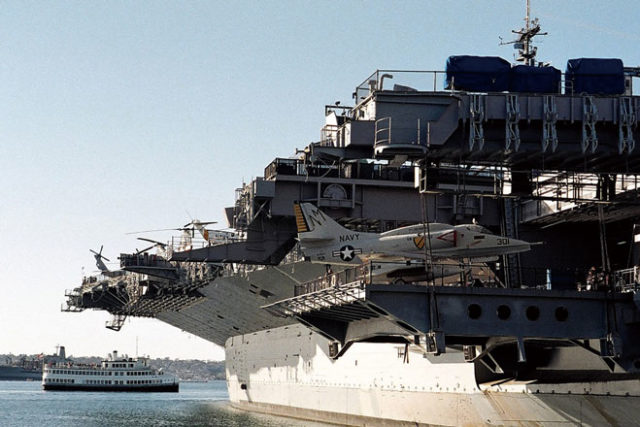By Nick Turner
For The North American Post
I was in California the other day visiting a friend when we decided to tour the USS Midway, an aircraft carrier turned floating museum that now resides in San Diego along the city’s waterfront.
In its heyday, the Midway was the largest ship in the U.S. Navy and saw action in the Vietnam War and later in the 90s during the Gulf War. During its time on the sea, the Midway travelled to all four corners of the globe. In June 1955, the ship sailed for Puget Sound Naval Shipyard on Bremerton Island—West of Seattle—where she received a few upgrades. In the late 50s the Midway began annual deployments to the South China Sea during the Laotian crisis of 1961. The ship sailed to East Asia in 1962 to test the air defense systems of Japan, Korea, Okinawa, the Philippines and Taiwan. She travelled to Vietnam three years later, at the height of the war.
The Midway was commissioned on Sept. 10, 1945, just eight days after the surrender of Japan. She served as the Persian Gulf flagship during Operation Desert Storm in 1991. Later that year, the Midway departed Yokosuka and returned to Pearl Harbor; here it was replaced by the Independence as the forward-deployed carrier in Japan. The Midway then sailed to Seattle for a port visit before its final voyage to San Diego, where it was put to rest after 47 years of service.
I had my camera when my friend and I were touring the ship. I snapped pictures as we made our way through the ship’s innards and up to the flight deck, where fighter jets and helicopters were displayed. An odd thought struck me as I was looking through the viewfinder of my camera.
“That’s weird,” I told my friend standing next to me. “I’m using a German camera, paired with a Japanese lens, to take pictures of an aircraft carrier from the U.S. Navy.”
My camera was in a strange position, to say the least, but I quickly realized that I symbolized an even quirkier twist in history.
I am half-Japanese, half-American; both of my grandfathers served in World War II. I wonder how they would feel, knowing that I just toured a decommissioned warship from the war in which they fought each other.
I had a similar feeling weeks ago when I learned that Seattle University—where I am currently studying—is where Japantown, or Nihonmachi, used to be.
I believe most of the readers know this story: a wave of Japanese immigrants came to Seattle during the mid-1880s, established a community here and thrived despite opposition from white business owners until the 1941 attack on Pearl Harbor, after which they were sent to internment camps until the end of the war. Since most of their possessions and properties had been stolen or sold in their absence, they stayed in churches, schools and orphanages for months after their return.
I am just a kid, born half a century after all of this happened, looking back at one of history’s lessons that never sunk in. But I love Japan, and it pains me to imagine what my people went through all those years ago. The war carved a hole in the hearts and homes of this community.
All I know is that history repeats itself. People make the same mistakes, over and over again, holding onto the foolish hope that things will change. Japanese people along the west coast of the United States suffered greatly at the hands of misguided fear and racism.
There are people in this country, right now, who fear they may face similar consequences. I believe members of the Nikkei community stand in a unique position to help, so that one day a Muslim or black or brown or gay or queer or transgender child can look back at history and appreciate the irony of their present situation, just like I did on the flight deck of the USS Midway.




